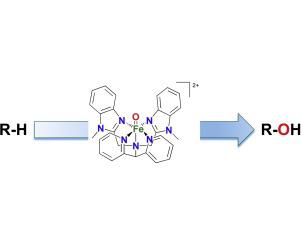Journal of Molecular Catalysis A: Chemical Pub Date : 2016-10-11 , DOI: 10.1016/j.molcata.2016.10.010 Mainak Mitra , Hassan Nimir , David A. Hrovat , Albert A. Shteinman , Michael G. Richmond , Miquel Costas , Ebbe Nordlander

|
The oxidation reactions of alkanes with hydrogen peroxide and peracids (peracetic acid (PAA) and m-chloroperoxybenzoic acid (mCPBA)) catalysed by two Fe(II) complexes of pentadentate {N5}-donor ligands have been investigated. Kinetic isotope effect experiments and the use of other mechanistic probes have also been performed. While the total yields of oxidized products are similar regardless of oxidant (e.g. 30–39% for oxidation of cyclohexane), the observed alcohol/ketone ratios and kinetic isotope effects differ significantly with different oxidants. Catalytic reactions in H2O2 medium are consistent with the involvement of hydroxyl radicals in the CH bond cleavage step, and resultant low kinetic isotope effect values. On the other hand, catalytic reactions performed using peracid media indicate the involvement of an oxidant different from the hydroxyl radical. For these reactions, the kinetic isotope effect values are relatively high (within a range of 4.2–5.1) and the C3/C2 selectivity parameters in adamantane oxidation are greater than 11, thereby excluding the presence of hydroxyl radicals in the C
H bond cleavage step. A low spin Fe(III)-OOH species has been detected in the H2O2-based catalytic system by UV/Vis, mass spectrometry and EPR spectroscopy, while an Fe(IV)-oxo species is postulated to be the active oxidant in the peracid-based catalytic systems. Computational studies on the C
H oxidation mechanism reveal that while the hydroxyl radical is mainly responsible for the H-atom abstraction in the H2O2-based catalytic system, it is the Fe(IV)-oxo species that abstracts the H-atom from the substrate in the peracid-based catalytic systems, in agreement with the experimental observations.
中文翻译:

两个五齿配体的非血红素单核Fe(II)配合物催化CH氧化:Fe(IV)羰基中间体的证据
烷烃与过氧化氢和过酸的氧化反应(过乙酸(PAA)和中号氯过氧苯甲酸(mCPBA))由两个铁催化的(II)五齿{N的复合物5 }端供体配位体进行了研究。动力学同位素效应实验和其他机械探针的使用也已进行。尽管与氧化剂无关,氧化产物的总收率相似(例如,环己烷的氧化率为30–39%),但观察到的醇/酮比和动力学同位素效应因不同的氧化剂而显着不同。H 2 O 2介质中的催化反应与C中羟基的参与一致H键裂解步骤,以及由此产生的低动力学同位素效应值。另一方面,使用过酸介质进行的催化反应表明与羟基自由基不同的氧化剂的参与。对于这些反应,动力学同位素效应值较高(在4.2-5.1范围内),金刚烷氧化中的C3 / C2选择性参数大于11,从而排除了在C
H键裂解步骤中存在羟基自由基的情况。。通过UV / Vis,质谱和EPR光谱在基于H 2 O 2的催化体系中检测到低自旋的Fe(III)-OOH物质,而假定Fe(IV)-氧代物质为活性氧化剂在基于过酸的催化体系中。关于C的计算研究
H氧化机理表明,虽然羟基自由基主要负责基于H 2 O 2的催化体系中H原子的提取,但Fe(IV)-oxo物种却从H2O 2的底物中提取H原子。基于过酸的催化体系,与实验结果一致。











































 京公网安备 11010802027423号
京公网安备 11010802027423号